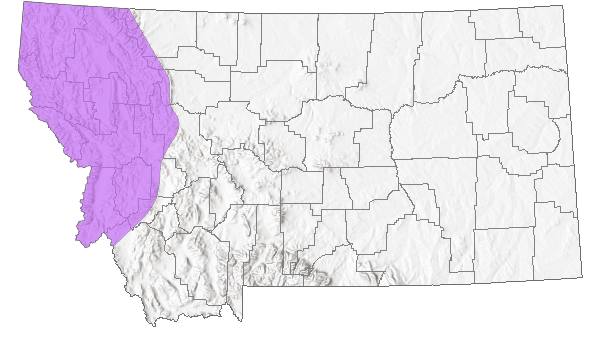View in other NatureServe Network Field Guides
NatureServe
Montana
Utah
Wyoming
Idaho
Wisconsin
British Columbia
South Carolina
Yukon
California
New York
Black-tipped Darner - Aeshna tuberculifera
State Rank Reason (see State Rank above)
The Black-tipped Darner is currently ranked S2S4 as a "potential species of concern" in Montana because it is potentially at risk of extirpation in the state, due to limited and/or declining numbers, range and/or habitat, even though it may be abundant in some areas.
General Description
The Black-tipped Darner is a relatively uncommonly occurring member of the family Aeshnidae in western Montana, and a potential species of concern. Preferred habitat and breeding sites include clear lakes and ponds often with acid, boggy vegetation in forested regions, as well as some vegetated streams (Dunkle 2000, Paulson 2009). The Black-tipped Darner is distinctive with no face line, and its lateral thoracic stripes broad straight, yellow-white to pale blue, S10 is Black most other mosaic darners with straight thoracic stripes have a pale spot on S10. Associated Wetland ecological systems are: Western Emergent Marsh, Northern Rocky Mountain Wooded Vernal Pool and the Rocky Mountain Subalpine-Montane Fen.
Diagnostic Characteristics
The Black-tipped Darner is distinctive with no face line, and its lateral thoracic stripes broad straight, yellow-white to pale blue, S10 is Black most other mosaic darners with straight thoracic stripes have a pale spot on S10.
Species Range
Montana Range
Range Descriptions

 Native
Native
Range Comments
Black-tipped Darners are widespread across northern Canada: Alberta, British Columbia, Manitoba, Newfoundland, North West Territories, Ontario, Quebec, Yukon; and the northern United States: Colorado, New Hampshire, Wyoming south to North Carolina in the east. Black-tipped Darners are usually encountered at higher latitudes or at higher elevations at lower latitudes. They are often the most commonly encountered darner species in the extreme north. In Montana, found in the western Middle Rockies forested region of the state.
Observations in Montana Natural Heritage Program Database
Number of Observations: 39
(Click on the following maps and charts to see full sized version)
Map Help and Descriptions
Relative Density

Recency



 (Observations spanning multiple months or years are excluded from time charts)
(Observations spanning multiple months or years are excluded from time charts)
Habitat
Black-tipped Darner breeding sites include clear lakes and ponds often with acid, boggy vegetation in forested regions, as well as some vegetated streams (Dunkle 2000, Paulson 2009). Away from water, this species forages along forest openings and edges and tends to perch on saplings (Dunkle 2000).
National Vegetation Classification System Groups Associated with this Species
Forest and Woodland
Montane - Subalpine Forest and Woodland
Grassland
Montane - Subalpine Grassland
Wetland and Riparian
Alkaline - Saline Wetlands
Peatland
Riparian and Wetland Forest
Riparian Shrubland
Wet Meadow and Marsh
Food Habits
Larvae feed on a wide variety of aquatic insects, such as mosquito larvae, other aquatic fly larvae, mayfly larvae, and freshwater shrimp. They will also eat very small fish and tadpoles.
Adult- The dragonfly will eat almost any soft-bodied flying insect including mosquitoes, flies, small moths, mayflies, and flying ants or termites.
Ecology
In Montana, males have been collected more rarely than females at oviposition sites (Miller and Gustafson 1996).
Reproductive Characteristics
Male Black-tipped Darners patrol along shorelines above vegetation as well as over open water. Females often mimic male behavior to avoid unwanted harassment prior to oviposition. Oviposition occurs during late afternoon and into evening where female will lay eggs both well above and at waterline into a variety of emergent vegetation including cattails, irises, and bur-reeds. Floating plants in water, dry grass or mud of drying ponds are also likely ovipostion sites (Dunkle 2000, Paulson 2009).
Stewardship Responsibility
References
- Literature Cited AboveLegend:
 View Online Publication
View Online Publication Miller, K.B. and D.L. Gustafson. 1996. Distribution records of the Odonata of Montana. Bulletin of American Odonatology 3(4):75-88.
Miller, K.B. and D.L. Gustafson. 1996. Distribution records of the Odonata of Montana. Bulletin of American Odonatology 3(4):75-88.
- Additional ReferencesLegend:
 View Online Publication
View Online Publication
Do you know of a citation we're missing? Dunkle, S.W. 2000. Dragonflies through binoculars: A field guide to dragonflies of North America. New York, NY. Oxford University Press. 266 pp.
Dunkle, S.W. 2000. Dragonflies through binoculars: A field guide to dragonflies of North America. New York, NY. Oxford University Press. 266 pp. Paulson, D.R. 2009. Dragonflies and Damselflies of the West. Princeton University Press, Princeton. 535 pp.
Paulson, D.R. 2009. Dragonflies and Damselflies of the West. Princeton University Press, Princeton. 535 pp.
- Web Search Engines for Articles on "Black-tipped Darner"
- Additional Sources of Information Related to "Insects"





